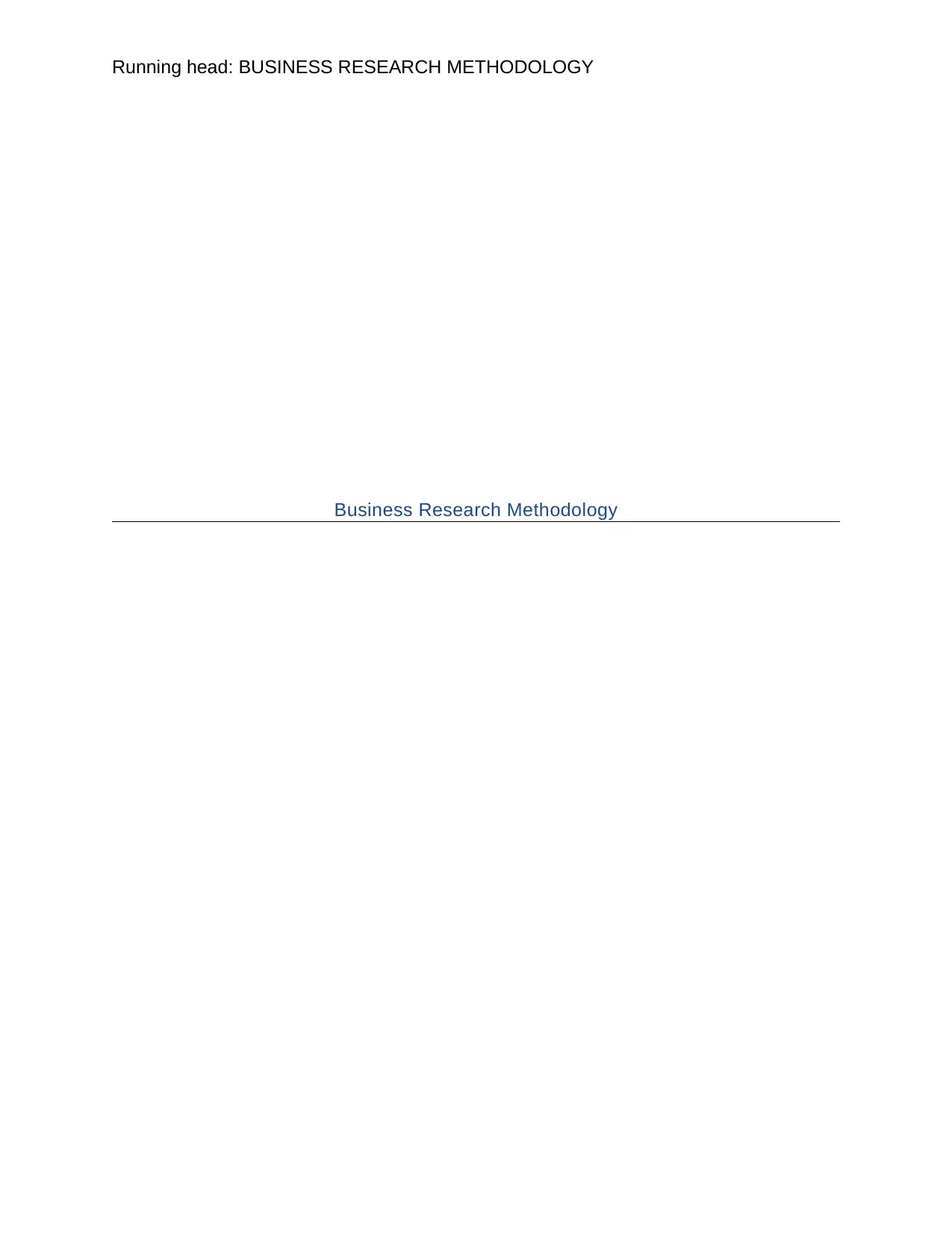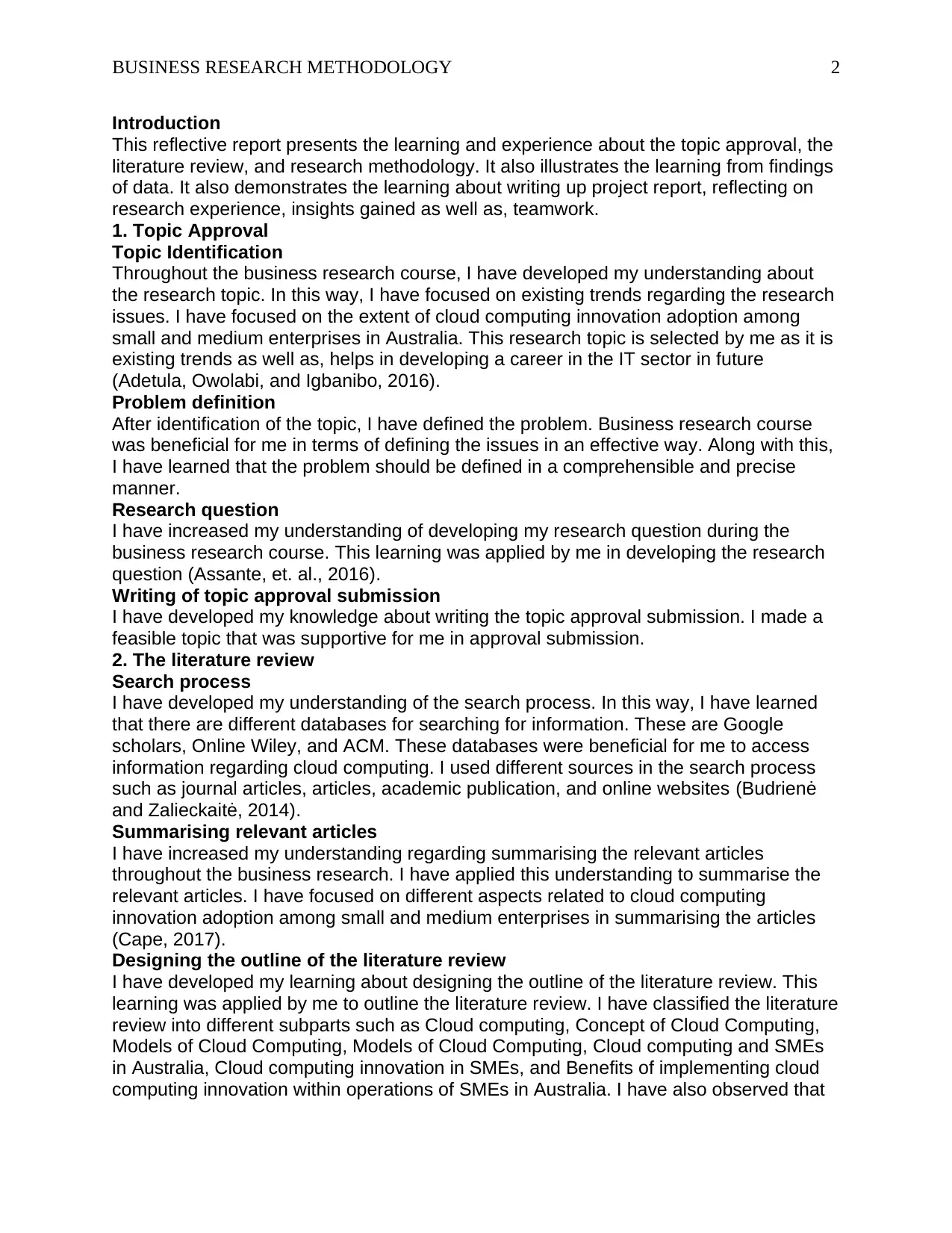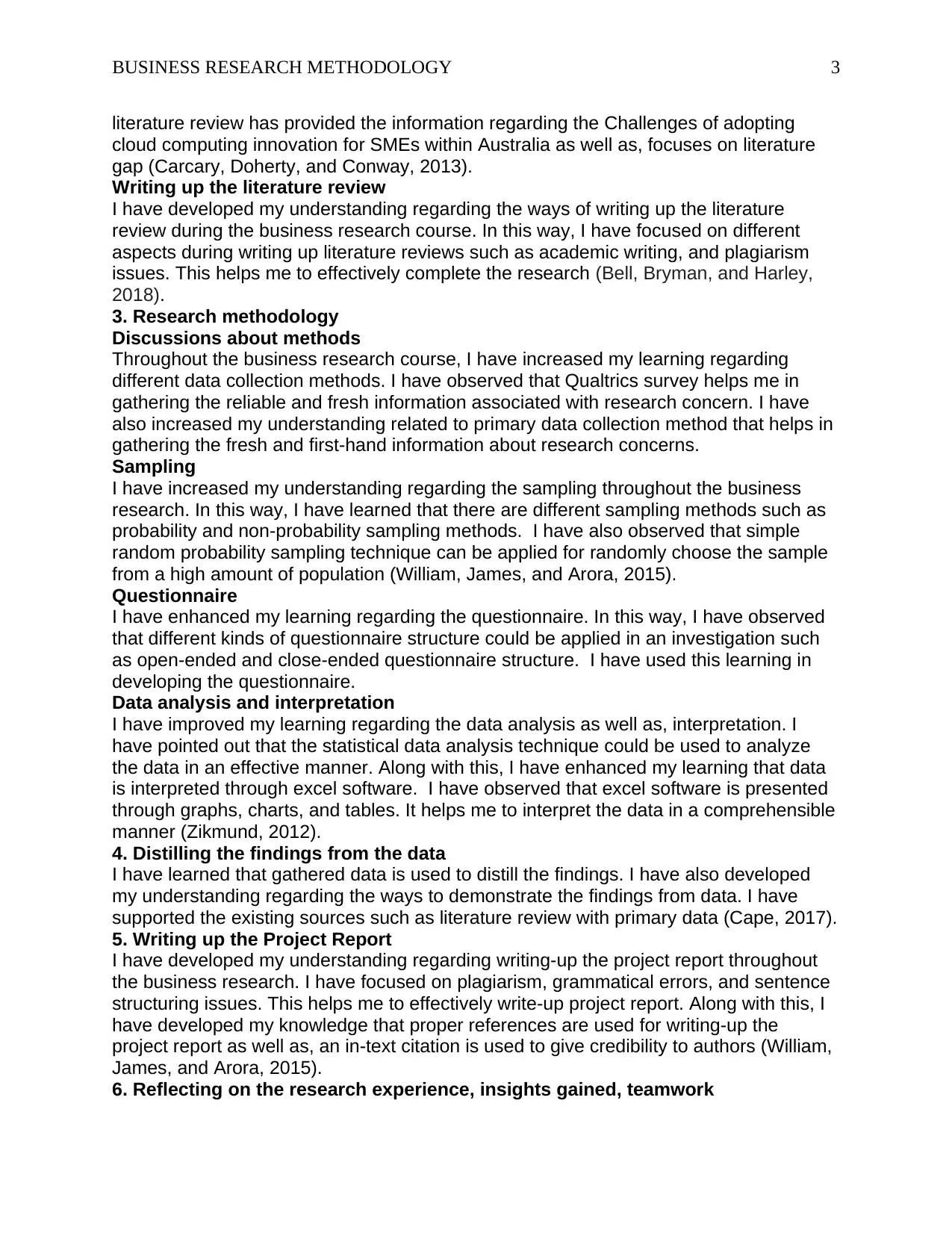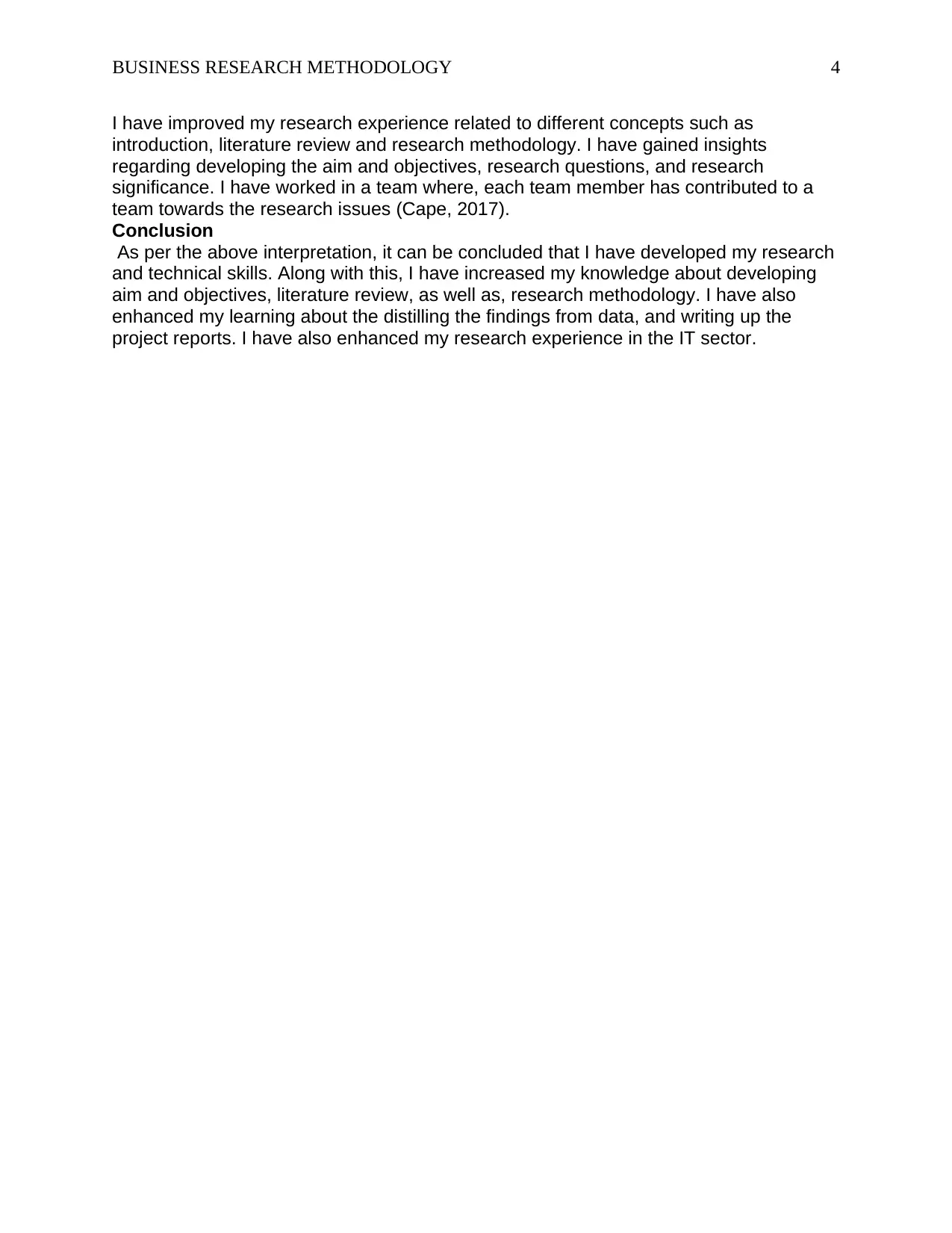BUS5003 Business Research Methodology: Reflective Journal Report
VerifiedAdded on 2022/12/22
|5
|1448
|65
Journal and Reflective Writing
AI Summary
This reflective report provides a comprehensive overview of a student's learning journey in a business research methodology course. It details the process of topic approval, including topic identification, problem definition, and the formulation of research questions. The report further explores the literature review process, encompassing the search process, summarization of relevant articles, and the design and writing of the literature review. The research methodology section covers data collection methods, sampling techniques, questionnaire design, and data analysis and interpretation. The report also discusses the distillation of findings from data and the writing of the project report, including reflections on research experience, insights gained, and teamwork. The student reflects on the practical application of these concepts within the context of cloud computing adoption among small and medium enterprises in Australia. The report concludes with a synthesis of the skills and knowledge acquired throughout the course, emphasizing the development of research and technical skills and the ability to apply these skills in the IT sector.

Running head: BUSINESS RESEARCH METHODOLOGY
Business Research Methodology
Business Research Methodology
Paraphrase This Document
Need a fresh take? Get an instant paraphrase of this document with our AI Paraphraser

BUSINESS RESEARCH METHODOLOGY 2
Introduction
This reflective report presents the learning and experience about the topic approval, the
literature review, and research methodology. It also illustrates the learning from findings
of data. It also demonstrates the learning about writing up project report, reflecting on
research experience, insights gained as well as, teamwork.
1. Topic Approval
Topic Identification
Throughout the business research course, I have developed my understanding about
the research topic. In this way, I have focused on existing trends regarding the research
issues. I have focused on the extent of cloud computing innovation adoption among
small and medium enterprises in Australia. This research topic is selected by me as it is
existing trends as well as, helps in developing a career in the IT sector in future
(Adetula, Owolabi, and Igbanibo, 2016).
Problem definition
After identification of the topic, I have defined the problem. Business research course
was beneficial for me in terms of defining the issues in an effective way. Along with this,
I have learned that the problem should be defined in a comprehensible and precise
manner.
Research question
I have increased my understanding of developing my research question during the
business research course. This learning was applied by me in developing the research
question (Assante, et. al., 2016).
Writing of topic approval submission
I have developed my knowledge about writing the topic approval submission. I made a
feasible topic that was supportive for me in approval submission.
2. The literature review
Search process
I have developed my understanding of the search process. In this way, I have learned
that there are different databases for searching for information. These are Google
scholars, Online Wiley, and ACM. These databases were beneficial for me to access
information regarding cloud computing. I used different sources in the search process
such as journal articles, articles, academic publication, and online websites (Budrienė
and Zalieckaitė, 2014).
Summarising relevant articles
I have increased my understanding regarding summarising the relevant articles
throughout the business research. I have applied this understanding to summarise the
relevant articles. I have focused on different aspects related to cloud computing
innovation adoption among small and medium enterprises in summarising the articles
(Cape, 2017).
Designing the outline of the literature review
I have developed my learning about designing the outline of the literature review. This
learning was applied by me to outline the literature review. I have classified the literature
review into different subparts such as Cloud computing, Concept of Cloud Computing,
Models of Cloud Computing, Models of Cloud Computing, Cloud computing and SMEs
in Australia, Cloud computing innovation in SMEs, and Benefits of implementing cloud
computing innovation within operations of SMEs in Australia. I have also observed that
Introduction
This reflective report presents the learning and experience about the topic approval, the
literature review, and research methodology. It also illustrates the learning from findings
of data. It also demonstrates the learning about writing up project report, reflecting on
research experience, insights gained as well as, teamwork.
1. Topic Approval
Topic Identification
Throughout the business research course, I have developed my understanding about
the research topic. In this way, I have focused on existing trends regarding the research
issues. I have focused on the extent of cloud computing innovation adoption among
small and medium enterprises in Australia. This research topic is selected by me as it is
existing trends as well as, helps in developing a career in the IT sector in future
(Adetula, Owolabi, and Igbanibo, 2016).
Problem definition
After identification of the topic, I have defined the problem. Business research course
was beneficial for me in terms of defining the issues in an effective way. Along with this,
I have learned that the problem should be defined in a comprehensible and precise
manner.
Research question
I have increased my understanding of developing my research question during the
business research course. This learning was applied by me in developing the research
question (Assante, et. al., 2016).
Writing of topic approval submission
I have developed my knowledge about writing the topic approval submission. I made a
feasible topic that was supportive for me in approval submission.
2. The literature review
Search process
I have developed my understanding of the search process. In this way, I have learned
that there are different databases for searching for information. These are Google
scholars, Online Wiley, and ACM. These databases were beneficial for me to access
information regarding cloud computing. I used different sources in the search process
such as journal articles, articles, academic publication, and online websites (Budrienė
and Zalieckaitė, 2014).
Summarising relevant articles
I have increased my understanding regarding summarising the relevant articles
throughout the business research. I have applied this understanding to summarise the
relevant articles. I have focused on different aspects related to cloud computing
innovation adoption among small and medium enterprises in summarising the articles
(Cape, 2017).
Designing the outline of the literature review
I have developed my learning about designing the outline of the literature review. This
learning was applied by me to outline the literature review. I have classified the literature
review into different subparts such as Cloud computing, Concept of Cloud Computing,
Models of Cloud Computing, Models of Cloud Computing, Cloud computing and SMEs
in Australia, Cloud computing innovation in SMEs, and Benefits of implementing cloud
computing innovation within operations of SMEs in Australia. I have also observed that

BUSINESS RESEARCH METHODOLOGY 3
literature review has provided the information regarding the Challenges of adopting
cloud computing innovation for SMEs within Australia as well as, focuses on literature
gap (Carcary, Doherty, and Conway, 2013).
Writing up the literature review
I have developed my understanding regarding the ways of writing up the literature
review during the business research course. In this way, I have focused on different
aspects during writing up literature reviews such as academic writing, and plagiarism
issues. This helps me to effectively complete the research (Bell, Bryman, and Harley,
2018).
3. Research methodology
Discussions about methods
Throughout the business research course, I have increased my learning regarding
different data collection methods. I have observed that Qualtrics survey helps me in
gathering the reliable and fresh information associated with research concern. I have
also increased my understanding related to primary data collection method that helps in
gathering the fresh and first-hand information about research concerns.
Sampling
I have increased my understanding regarding the sampling throughout the business
research. In this way, I have learned that there are different sampling methods such as
probability and non-probability sampling methods. I have also observed that simple
random probability sampling technique can be applied for randomly choose the sample
from a high amount of population (William, James, and Arora, 2015).
Questionnaire
I have enhanced my learning regarding the questionnaire. In this way, I have observed
that different kinds of questionnaire structure could be applied in an investigation such
as open-ended and close-ended questionnaire structure. I have used this learning in
developing the questionnaire.
Data analysis and interpretation
I have improved my learning regarding the data analysis as well as, interpretation. I
have pointed out that the statistical data analysis technique could be used to analyze
the data in an effective manner. Along with this, I have enhanced my learning that data
is interpreted through excel software. I have observed that excel software is presented
through graphs, charts, and tables. It helps me to interpret the data in a comprehensible
manner (Zikmund, 2012).
4. Distilling the findings from the data
I have learned that gathered data is used to distill the findings. I have also developed
my understanding regarding the ways to demonstrate the findings from data. I have
supported the existing sources such as literature review with primary data (Cape, 2017).
5. Writing up the Project Report
I have developed my understanding regarding writing-up the project report throughout
the business research. I have focused on plagiarism, grammatical errors, and sentence
structuring issues. This helps me to effectively write-up project report. Along with this, I
have developed my knowledge that proper references are used for writing-up the
project report as well as, an in-text citation is used to give credibility to authors (William,
James, and Arora, 2015).
6. Reflecting on the research experience, insights gained, teamwork
literature review has provided the information regarding the Challenges of adopting
cloud computing innovation for SMEs within Australia as well as, focuses on literature
gap (Carcary, Doherty, and Conway, 2013).
Writing up the literature review
I have developed my understanding regarding the ways of writing up the literature
review during the business research course. In this way, I have focused on different
aspects during writing up literature reviews such as academic writing, and plagiarism
issues. This helps me to effectively complete the research (Bell, Bryman, and Harley,
2018).
3. Research methodology
Discussions about methods
Throughout the business research course, I have increased my learning regarding
different data collection methods. I have observed that Qualtrics survey helps me in
gathering the reliable and fresh information associated with research concern. I have
also increased my understanding related to primary data collection method that helps in
gathering the fresh and first-hand information about research concerns.
Sampling
I have increased my understanding regarding the sampling throughout the business
research. In this way, I have learned that there are different sampling methods such as
probability and non-probability sampling methods. I have also observed that simple
random probability sampling technique can be applied for randomly choose the sample
from a high amount of population (William, James, and Arora, 2015).
Questionnaire
I have enhanced my learning regarding the questionnaire. In this way, I have observed
that different kinds of questionnaire structure could be applied in an investigation such
as open-ended and close-ended questionnaire structure. I have used this learning in
developing the questionnaire.
Data analysis and interpretation
I have improved my learning regarding the data analysis as well as, interpretation. I
have pointed out that the statistical data analysis technique could be used to analyze
the data in an effective manner. Along with this, I have enhanced my learning that data
is interpreted through excel software. I have observed that excel software is presented
through graphs, charts, and tables. It helps me to interpret the data in a comprehensible
manner (Zikmund, 2012).
4. Distilling the findings from the data
I have learned that gathered data is used to distill the findings. I have also developed
my understanding regarding the ways to demonstrate the findings from data. I have
supported the existing sources such as literature review with primary data (Cape, 2017).
5. Writing up the Project Report
I have developed my understanding regarding writing-up the project report throughout
the business research. I have focused on plagiarism, grammatical errors, and sentence
structuring issues. This helps me to effectively write-up project report. Along with this, I
have developed my knowledge that proper references are used for writing-up the
project report as well as, an in-text citation is used to give credibility to authors (William,
James, and Arora, 2015).
6. Reflecting on the research experience, insights gained, teamwork
⊘ This is a preview!⊘
Do you want full access?
Subscribe today to unlock all pages.

Trusted by 1+ million students worldwide

BUSINESS RESEARCH METHODOLOGY 4
I have improved my research experience related to different concepts such as
introduction, literature review and research methodology. I have gained insights
regarding developing the aim and objectives, research questions, and research
significance. I have worked in a team where, each team member has contributed to a
team towards the research issues (Cape, 2017).
Conclusion
As per the above interpretation, it can be concluded that I have developed my research
and technical skills. Along with this, I have increased my knowledge about developing
aim and objectives, literature review, as well as, research methodology. I have also
enhanced my learning about the distilling the findings from data, and writing up the
project reports. I have also enhanced my research experience in the IT sector.
I have improved my research experience related to different concepts such as
introduction, literature review and research methodology. I have gained insights
regarding developing the aim and objectives, research questions, and research
significance. I have worked in a team where, each team member has contributed to a
team towards the research issues (Cape, 2017).
Conclusion
As per the above interpretation, it can be concluded that I have developed my research
and technical skills. Along with this, I have increased my knowledge about developing
aim and objectives, literature review, as well as, research methodology. I have also
enhanced my learning about the distilling the findings from data, and writing up the
project reports. I have also enhanced my research experience in the IT sector.
Paraphrase This Document
Need a fresh take? Get an instant paraphrase of this document with our AI Paraphraser

BUSINESS RESEARCH METHODOLOGY 5
References
Adetula, D. Owolabi, F. and Igbanibo, S. 2016. Extent Of Adoption Of International
Financial Reporting Standards (IFRS) For Small And Medium Scale Enterprises (SMEs)
In Nigeria. European Journal of Business Research, 16(2), pp. 47-52.
Assante, D., Castro, M., Hamburg, I. and Martin, S., 2016. The use of cloud computing
in SMEs. Procedia computer science, 83, pp.1207-1212.
Bell, E., Bryman, A. and Harley, B., 2018. Business research methods. USA: Oxford
university press.
Budrienė, D. and Zalieckaitė, L. 2014. Cloud Computing Application In Small And
Medium-Sized Enterprises. Issues of Business and Law, 4, pp. 119-130.
Cape, P. 2017. Questionnaire design: who cares?. Research World, 66, pp. 42-43.
Carcary, M. Doherty, E. and Conway, G. 2014. The Adoption of Cloud Computing by
Irish SMEs - an Exploratory Study. Electronic Journal of Information Systems
Evaluation, 17(1), pp. 3-14.
William, T., James, P. and Arora, K. 2015. Research Methods: The essential knowledge
base. 2nd edn. USA: Cengage.
Zikmund, W. G. 2012. Business Research Methods. 9th edn. USA: Cengage.
References
Adetula, D. Owolabi, F. and Igbanibo, S. 2016. Extent Of Adoption Of International
Financial Reporting Standards (IFRS) For Small And Medium Scale Enterprises (SMEs)
In Nigeria. European Journal of Business Research, 16(2), pp. 47-52.
Assante, D., Castro, M., Hamburg, I. and Martin, S., 2016. The use of cloud computing
in SMEs. Procedia computer science, 83, pp.1207-1212.
Bell, E., Bryman, A. and Harley, B., 2018. Business research methods. USA: Oxford
university press.
Budrienė, D. and Zalieckaitė, L. 2014. Cloud Computing Application In Small And
Medium-Sized Enterprises. Issues of Business and Law, 4, pp. 119-130.
Cape, P. 2017. Questionnaire design: who cares?. Research World, 66, pp. 42-43.
Carcary, M. Doherty, E. and Conway, G. 2014. The Adoption of Cloud Computing by
Irish SMEs - an Exploratory Study. Electronic Journal of Information Systems
Evaluation, 17(1), pp. 3-14.
William, T., James, P. and Arora, K. 2015. Research Methods: The essential knowledge
base. 2nd edn. USA: Cengage.
Zikmund, W. G. 2012. Business Research Methods. 9th edn. USA: Cengage.
1 out of 5
Related Documents
Your All-in-One AI-Powered Toolkit for Academic Success.
+13062052269
info@desklib.com
Available 24*7 on WhatsApp / Email
![[object Object]](/_next/static/media/star-bottom.7253800d.svg)
Unlock your academic potential
Copyright © 2020–2025 A2Z Services. All Rights Reserved. Developed and managed by ZUCOL.




